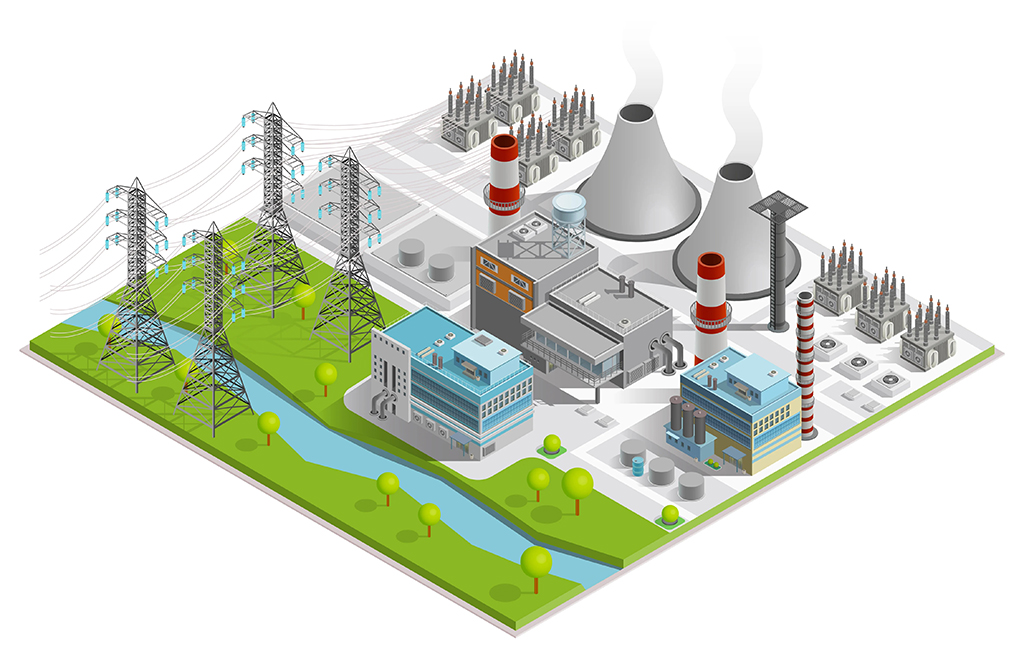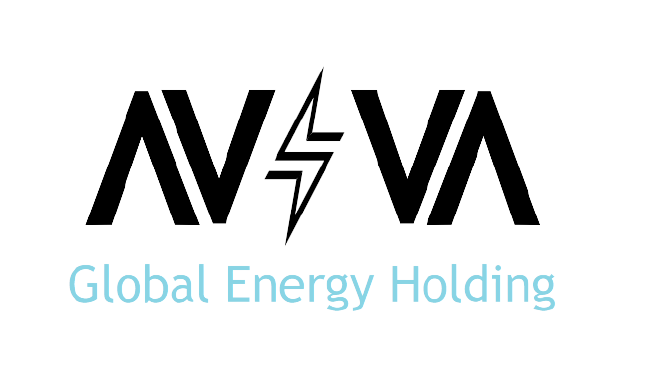Thermal Power Plants
Types of Thermal Energy
![]() Coal Power Plant
Coal Power Plant
![]() Natural Gas Power Plant
Natural Gas Power Plant
![]() Fuel Oil Power Plant
Fuel Oil Power Plant
![]() Diesel Oil Power Plant
Diesel Oil Power Plant
![]() Biomass Power Plant
Biomass Power Plant

Coal Power Plant
Almost all coal-fired power stations, petroleum, nuclear, geothermal, solar thermal electric, and waste incineration plants, as well as all natural gas power stations are thermal.
Natural gas is frequently burned in gas turbines as well as boilers. The waste heat from a gas turbine, in the form of hot exhaust gas, can be used to raise steam by passing this gas through a heat recovery steam generator (HRSG).
The steam is then used to drive a steam turbine in a combined cycle plant that improves overall efficiency. Power stations burning coal, fuel oil, or natural gas are often called fossil fuel power stations.
Natural Gas Power Plant
Natural gas power plants generate electricity by burning natural gas as their fuel. There are many types of natural gas power plants which all generate electricity, but serve different purposes. All natural gas plants use a gas turbine; natural gas is added, along with a stream of air, which combusts and expands through this turbine causing a generator to spin making electricity.
Natural gas power plants are cheap and quick to build. They also have very high thermodynamic efficiencies compared to other power plants.
There is waste heat that comes from this process. Some natural gas plants can use this waste heat as well, which is explained below.
Burning of natural gas produces fewer pollutants like NOx, SOx and particulate matter than coal and oil.Natural gas plants significantly contribute to climate change, and that contribution is growing. Natural gas power plants produce considerable carbon dioxide, although less than coal plants do.


Natural gas turbines are theoretically simple and have three main parts as seen in below
⦁ Compressor
Takes in air from outside of the turbine and increases its pressure.
⦁ Combustor
Burns the fuel and produces high pressure and high velocity gas.
⦁ Turbine
Extracts the energy from the gas coming from the combustor.
Modular Natural Gas Power Plant
Small IPPs (Independent Power Producers) who can afford small investment to start their businesses. Those who need power sources fast track. Those who are not connected to the national grid. Places where it difficult to have infrastructure(e.g. high voltage transmissions line). Small towns and isolated areas.
Fast Delivery And Installation
All the process of manufacturing, transportation, installation, and commissioning for a 80 MW takes just few months.
Easily Tranferable
Reinstallation of 1 PPS unit takes just 2 weeks. Even with more units, no additional time is required.
Low Operation Cost
30-70% lower operation cost compared to high speed gensets.
Easy Operation
The smart control system gives easy & efficient site operation for O&M managers.


Diesel Power Plants
Diesel engines are commonly used as mechanical engines, power generators
Industrial diesel engines and diesel-powered generators have construction, marine, mining, hospital, forestry, telecommunications, underground, and agricultural applications, just to name a few. Power generation for prime or standby backup power is the major application of today’s diesel generators.
Diesel Power Generators
Diesel powered generators, or electrical generator sets, are used in countless industrial and commercial establishments. The generators can be used for small loads, such as in homes, as well as for larger loads like industrial plants, hospitals, and commercial buildings.
We are installing power plants from 600kw to 100MW with diesel generator sets
Diesel power plants are the fastest power plant solution today
It is established in a very short time both as a fixed power plant
Diesel power plants Advantages
⦁ Quick setup
⦁ Quick solution
⦁ Fuel supply is faster and easier
⦁ Fuel storage is easier and safer
⦁ Ease of maintenance and operation
⦁ The ideal solution for mobile power
⦁ The best solution for emergency energy situations
⦁ Inexpensive faster and good solution for smal grid demand handling
Biomass Power Plant
Converting Biomass to Energy
Biomass is converted to energy through various processes, including:
⦁ Direct combustion to produce heat
⦁ Chemical conversion to produce liquid fuels
⦁ Biological conversion to produce liquid and gaseous fuels
⦁ Thermochemical conversion to produce solid, gaseous, and liquid fuels
Direct Combustion:Direct combustion is the most common method for converting biomass to useful energy. All biomass can be burned directly for heating buildings and water, for industrial process heat, and for generating electricity in steam turbines.


Chemical conversion to produce liquid fuels : A chemical conversion process known as transesterification is used for converting vegetable oils, animal fats, and greases into fatty acid methyl esters (FAME), which are used to produce biodiesel.
Biological Conversion to Produce Liquid and Gaseous Fuels: Biological conversion includes fermentation to convert biomass into ethanol and anaerobic digestion to produce renewable natural gas.
Ethanol is used as a vehicle fuel. Renewable natural gas also called biogas or biomethane is produced in anaerobic digesters at sewage treatment plants and at dairy and livestock operations
Thermochemical conversion to produce solid, gaseous, and liquid fuels: Thermochemical conversion of biomass includes pyrolysis and gasification. Both are thermal decomposition processes in which biomass feedstock materials are heated in closed, pressurized vessels called gassifiers at high temperatures.
Pyrolysis: Entails heating organic materials to 400–500 oC in the near complete absence of free oxygen. Biomass pyrolysis produces fuels such as charcoal, bio-oil, renewable diesel, methane, and hydrogen.
Hydrotreating: It is used to process bio-oil with hydrogen under elevated temperatures and pressures in the presence of a catalyst to produce renewable diesel, renewable gasoline, and renewable jet fuel.
Gasification: Entails heating organic materials to 800–900oC with injections of controlled amounts of free oxygen and/or steam into the vessel to produce a carbon monoxide and hydrogen rich gas called synthesis gas or syngas. Syngas can be used as a fuel for diesel engines, for heating, and for generating electricity in gas turbines.
Environmental Benefits
Gasification is a much cleaner process than combustion, it can create fewer air emissions and generate less waste than most traditional energy technologies.It helps reduce the environmental impact of waste disposal because it can use waste materials as feedstocks to generate valuable products from materials that would otherwise be disposed as wastes. Through waste recycling, it boosts sustainable development and contributes to world’s environmental construction.


AVVA HI-TECH GASIFICASION SYSTEM
PROCESS INFORMATION
Gasification is a simpler, safer, and more controllable remedy. Partially dried waste is fed to the gasifier unit by a synchronized apron type conveyor. Wastes are most commonly treated and reduced by either secondary drying or incineration processes. While drying will evaporate the water content it leaves the solid contaminant. While incineration will successfully burns off any combustible elements, it must do so at extremely high and costly temperatures.
These processes can not control the release of dioxins, furans, NOx, SOx, and other dangerous pollutants without the considerable expense and difficulty due to inefficient furnace design, inconsistent furnace temperatures, and failure to recirculate gases into the burner’s high temperature zone. Therefore the addition of after-burners and / or other emission control equipment is required to eliminate the release of pollutants.
CONTINUOUS PROCESS STEPS
⦁ Waste with 40 to 75 % moisture level will be dried down to 15 % moisture level utilizing a hollow paddle or another type of a drier. Thermal oil circulating in the drier will be heated by waste heat recovered from gas genset exhaust flue gas and gasification reactor stack flue gas using heat exchangers.
⦁ Partially dried waste is fed to the gasifier unit by a synchronized apron type conveyor.
⦁ Plug type air lock mechanism pushes waste into the reactor with a predetermined sequence to admit waste material into the gasification reactor without air getting into the reactor.
⦁ In the first stage, hydrocarbons are carbonized at the absence of air or oxygen by indirect heating using self produced producer gas as the process heat source up to approximately 600 degrees C. Resulting gas and the biochar is further conveyed to the second stage where char is gasified at around 800 degrees C with the aid of steam.
⦁ In this system tars are eliminated and hydrogen gas is maximized by changing char particle size, gasification temperature, and steam supply rate on gasification rate


Driven Solutions

Gen-Ship
Gen-Ship
Basically, Floating Power Plant is a Ship having Electric Power Generation capability.

Modular Power Plant

Waste Management
Waste Management
We offer modern waste management solutions, customized for the needs of our customers.
“We provide rapid solutions to energy demand problems globally”
